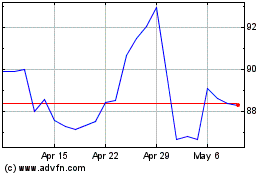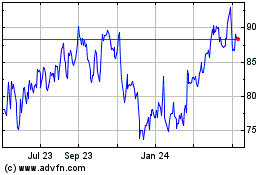By Ryan Dezember and Kevin Helliker
The late oil magnate Aubrey McClendon held his alma mater in
such high regard that he built the headquarters of his company in
the image of Duke University's campus.
And back in Durham, N.C., the feeling was mutual: There's the
McClendon Commons and McClendon Tower, McClendon Plaza and the
Kathleen Upton Byrns McClendon Pipe Organ. All told, Mr. McClendon
gave more than $20 million to the school where he met his wife,
sent his children and connected with the friend who would help
bankroll his rise.
Now, Duke is making a claim against the Chesapeake Energy Corp.
co-founder's estate, claiming it is owed almost half the $18.75
million he recently pledged, even though he died before he could
make good on it.
Mr. McClendon graduated in 1981 and became a major benefactor of
Duke after he struck riches in the oil patch. When he died in March
in a car crash in Oklahoma City, Mr. McClendon had unfunded
commitments to athletics funds, scholarships and campus-improvement
projects totaling about $9.94 million, the university said in a
probate court filing that became public late Tuesday.
Duke is the latest player in a complicated legal drama unfolding
in an Oklahoma City court, where a growing roster of creditors has
come forward with claims against the late wildcatter.
Mr. McClendon borrowed heavily to fund new business ventures and
gave generously to hometown projects and charitable organizations,
but the value of many of his energy-heavy holdings is in question
amid the biggest oil bust in a generation.
The move also raises questions about just how far recipients of
pledges should pursue money promised before a person's death.
Lawyers say the aggressive pursuit of an estate could hurt the
university's ability to persuade alumni to make the kind of firm
commitments its endowment needs to fund obligations into the
future.
In a statement, Duke called Mr. McClendon "one of Duke's most
passionate and generous alumni...This is a routine transaction that
in no way diminishes Duke's respect for the McClendon family and
our gratitude for their relationship to Duke."
Tom Blalock, a longtime associate of Mr. McClendon who is
administering his estate, didn't respond to requests for comment.
Mr. McClendon's creditors, which so far range from Wall Street
banks to a former employee to a farm-equipment maker, have until
Sept. 16 to file claims.
Mr. McClendon left behind a vast tangle of assets and debts when
his speeding Chevy Tahoe crashed into a concrete underpass the
morning of March 2. He had been ousted from Chesapeake over
corporate-governance issues three years earlier and had leveraged
many of his personal holdings to finance a comeback.
Collapsing oil prices in late 2014 strained the new oil-and-gas
empire he had assembled, and he struggled in his final year to
raise more cash to keep it afloat.
Oklahoma records show he had pledged assets as collateral for
loans, including his roughly 20% stake of the Oklahoma City Thunder
basketball team, fine wine, investments in tech startups and
antique boats.
Lawyers for Mr. McClendon's creditors have said they think Mr.
McClendon, who during his Chesapeake heyday was a billionaire, left
behind more debt than assets. The entrepreneur's debts so far
amount to about $500 million, according to Oklahoma probate
records.
But Martin Stringer, a lawyer for Mr. McClendon's estate, said
claiming it is insolvent is "incorrect" because "nobody has the
facts," according to a transcript of a May probate court hearing.
The value of many assets "depends on commodity prices," he added.
He said that the estate includes interests in more than 180
companies and other business ventures.
Duke's claim is the only one yet tied to McClendon's pledged
donations. The university said Mr. McClendon's commitments are in
writing and documented.
"If there's a signed letter of commitment, generally speaking,
that's considered legally binding," said Richard Marker, a
professor of philanthropy at the University of Pennsylvania and New
York University, who added that he doesn't know the specifics of
Mr. McClendon's pledge to Duke.
With documented pledges, Duke should have similar standing to
Mr. McClendon's unsecured creditors, said Laura Zwicker, a partner
at Los Angeles law firm Greenberg Glusker Fields Claman &
Machtinger LLP who specializes in estate matters for wealthy
clients. Government agencies, such as the Internal Revenue Service,
are paid first, followed by secured creditors, who receive the
value of their collateral, she said.
Whatever assets the estate has left are usually doled out
proportionally to unsecured creditors as well as secured creditors
whose claims were not satisfied by collateral, said Ms.
Zwicker.
Duke said that over the years, the McClendons have given more
than $20 million to the school. Mr. McClendon met his wife,
Kathleen McClendon, at Duke, and the couple sent each of their
three children there.
Duke is where Mr. McClendon met his close friend Ralph Eads, an
investment banker who years after their fraternity days helped Mr.
McClendon raise the cash needed to lease huge swaths of
shale-drilling property that made Chesapeake the country's
second-largest natural gas producer. He built Chesapeake's Oklahoma
City headquarters with rows of redbrick Georgian buildings in the
image of the campus.
McClendon Commons is a visitors' center adjacent to Duke's
admissions office. The McClendons gave at least $1.2 million for
the restoration of the massive pipe organ in the university's
chapel.
The university in 2002 tried to memorialize the couple with a
pair of gargoyles carved in their likenesses and installed above an
entrance to McClendon Tower, but the couple insisted they be
removed, according to news reports at the time.
People close to Duke said that news of the appeal caught at
least some members of the university's fundraising office by
surprise.
"How positive is it to see a university sue a donor?" asks Doug
White, former director of the nonprofit management program at
Columbia University. "If it were up to me, I wouldn't push it that
hard."
Duke ran into a problem with a pledge from a different donor a
decade ago. In 2003, Boston Scientific co-founder Peter Nicholas
pledged $72 million to Duke, which at the time made headlines as
the largest contribution in the school's history. The deadline for
payment was December 2008, but it was unfulfilled as of September
2010, according to The Chronicle, Duke's student newspaper. Mr.
Nicholas is still paying off the pledge, according to people
familiar with the matter. Mr. Nicholas, who retired as a director
of Boston Scientific in May, couldn't be reached for comment.
As of 2015 Duke University had the 18th largest endowment among
U.S. schools with $6.5 billion, according to the Council for Aid to
Education, a nonprofit organization that tracks endowments. Duke's
endowment nearly doubled from $3.3 billion over the past decade, an
increase in line with most schools.
--Ben Cohen and Douglas Belkin contributed to this article.
Write to Ryan Dezember at ryan.dezember@wsj.com and Kevin
Helliker at kevin.helliker@wsj.com
(END) Dow Jones Newswires
August 25, 2016 02:48 ET (06:48 GMT)
Copyright (c) 2016 Dow Jones & Company, Inc.
Chesapeake Energy (NASDAQ:CHK)
Historical Stock Chart
From Mar 2024 to Apr 2024

Chesapeake Energy (NASDAQ:CHK)
Historical Stock Chart
From Apr 2023 to Apr 2024
